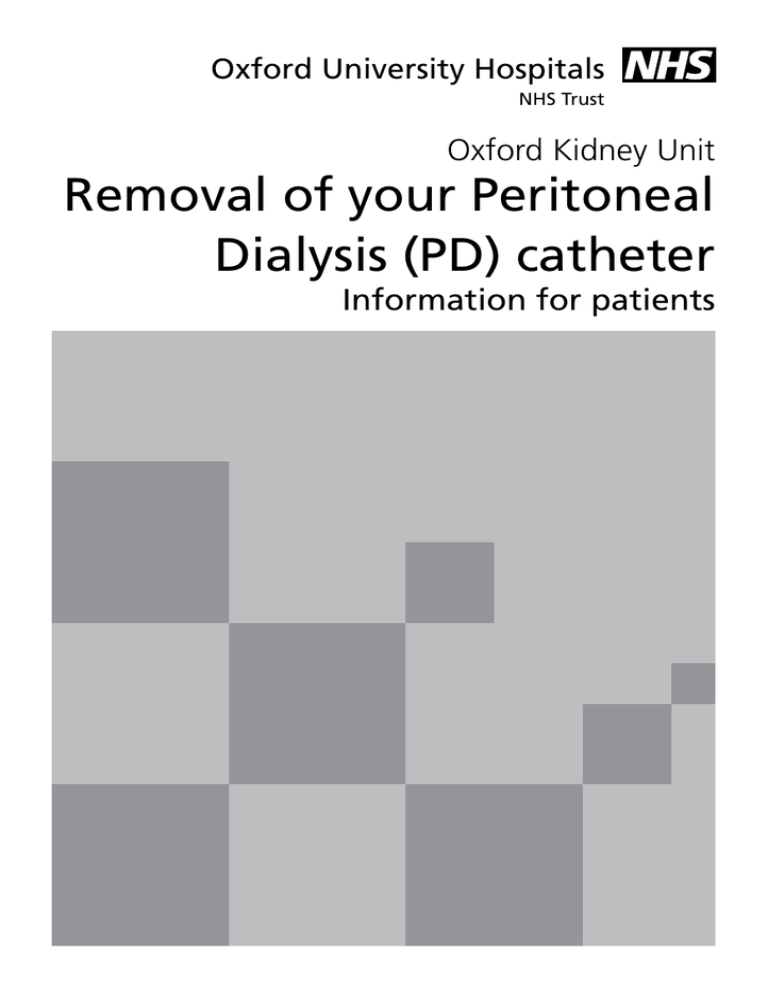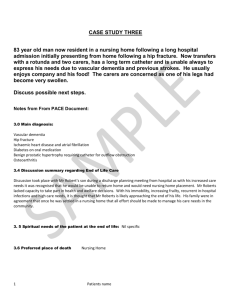Removal of your Peritoneal Dialysis (PD) catheter
advertisement

Oxford University Hospitals NHS Trust Oxford Kidney Unit Removal of your Peritoneal Dialysis (PD) catheter Information for patients This information is intended to help you understand how your PD catheter will be removed. If you require further information please do not hesitate to contact your PD nurse. Your PD catheter can be removed in one of two ways. Your kidney or transplant doctor will discuss with you which method is best for you. If you are taking medication such as warfarin or aspirin please contact the unit for advice 1 week before either of the procedures. The two methods are either a ‘PD pull’ or surgical removal of the PD catheter. The differences in the procedures are shown below: PD pull PD surgical operation No need for general anaesthetic and operation. Need to be fit for an operation / general anaesthesia (when you are made to sleep). Takes a few minutes. Procedure takes about 20 minutes, will be in hospital for 4-6 hours. No interruption to work / home schedule. No work for 1 – 2 weeks (depending on the type of work you do). Exit site should have healed in 2 days, no bathing / showers until completely healed. Exit site & wound – takes 7-10 days to heal, no bathing / showers during this time. Cuffs (which stop your PD catheter falling out) are left inside you. Cuffs removed at operation. page 2 Procedure can be carried out in a clinic room. Requires theatre admission, you may need pre op assessment prior to surgery (about a week before the operation). Cuffs may become infected at a later date (2 in 100 patients). Wounds may bleed, become infected (rare). Catheter may snap during procedure (rare). No heavy lifting for 3 weeks post operation. Can be uncomfortable during procedure. May be painful after the procedure. Can drive after the procedure. Cannot drive for 2-3 weeks after the operation. PD pull - how is the procedure is performed? After a nurse or doctor has explained the procedure to you, they will ask you to sign a consent form. We will then ask you to lie on a couch or bed. Your dressing will be removed and your exit site inspected (if there is any sign of infection a PD pull is not recommended). With one hand we will then apply firm pressure to your tummy around the PD catheter site. Holding the catheter in the other hand we will pull steadily and firmly on the catheter. After a few moments the tubing will slide out of your abdomen. Sometimes the superficial cuff (nearest the exit site) also slides out of your skin. A dressing is then applied. page 3 Surgical removal of a PD catheter – how is this procedure performed? This is performed using a mini ‘laparotomy’ operation and usually with a general anaesthesia (you are asleep). A small cut (4-5cm) is made just below your belly button. The surgeon surgically removes the catheter and cuffs from the abdominal cavity. The cut is closed using stitches on the inside. This type of operation is recommended for infected PD exit sites. The dressing will need to be replaced weekly until the wound has healed (about 2 weeks). For surgical removal of your PD catheter you will need to follow the instructions below Most patients are admitted to the Day Surgery Unit, which is found on Main Street in the original Churchill Hospital building. Please park in car park 5 and enter the building across the road from the zebra crossing. The Day Surgery Unit is on the left just before the League of Friends coffee shop. What time should you get to the Day Surgery Unit? • If your operation is in the morning you will need to arrive at 7:30am. • If your operation is in the afternoon you will need to arrive at 11:30am. What happens on the day of the operation? A nurse, surgeon and anaesthetist will see you before the operation and you will be asked to sign a consent form. Your nurse will then take you to theatre. After the operation you will be taken to the Recovery Unit. When you are fully awake you page 4 will return back to the Day Surgery Unit. You should be able to go home 3 – 4 hours after your operation. Most patients go home the same day. You must have a competent person to stay with you and take care of you for 24 hours. We do not provide painkillers to take home so recommend you have a supply of paracetamol, which can be taken as directed on the packet. Eating and drinking instructions for surgical removal of your PD catheter IF YOU ARE ON THE MORNING LIST IF YOU ARE ON THE AFTERNOON LIST Nothing to eat from midnight. Nothing to eat after 7:30am. You can drink (no milk*) up until 6.30am. You can drink (no milk*) up until 11:30am. Take all blood pressure and heart medication as normal. Take all blood pressure and heart medication as normal. DIABETIC PATIENTS DIABETIC PATIENTS Nothing to eat from midnight. Nothing to eat from midnight. You can drink (no milk*) up until 6:30am. You can drink (no milk*) up until 11:30am. EVENING BEFORE, take only ½ of your long acting diabetic medication. EVENING BEFORE, take your usual dose of insulin. DO NOT take your morning diabetic tablets or insulin. Take all blood pressure and heart medication as normal. Morning of surgery, take ½ dose of insulin or usual dose of oral diabetic medication with a light breakfast. Take all blood pressure and heart medication as normal. Do not eat, chew gum, or suck boiled sweets. *clear fluid i.e. black tea, black coffee or squash but not juice. page 5 Items to bring into hospital with you if your PD catheter is removed surgically • Medications in their original packaging • Dressing gown • A book or magazine • Overnight bag with nightclothes and toiletries (just in case you need to stay in hospital overnight). The majority of patients go home the same day. Instructions for returning home after both types of removal of your PD catheter Type of procedure / operation PD pull PD surgical operation Wound care There is usually no bleeding*, there are no stitches to be removed. Temporary bleeding* and bruising, there are no stitches to be removed. Bathing instructions Leave dressing in place for 2 days – no bathing or showers. Remove old dressings, replace with new ones if required. Should heal completely within 4 days. Leave dressing in place for 7 days – no bathing or showers. Remove old dressings, replace with new ones if required. Re-check dressings and wound 5 days later, should heal completely within 7 -14 days. page 6 Pain control You should be pain free once the procedure is completed. Take paracetamol as directed on the packet. Driving Driving – allowed. Do not drive for 2- 3 weeks after operation. Working No interruption to work schedule. Depending on your type of work it is best that you rest for 7-10 days before going back to your normal activities. If your work is physically demanding you may feel you need a longer time away from work to recover fully. If you experience severe abdominal pain, excessive bleeding*, or your wound / exit site becomes red / inflamed or painful contact your PD unit / renal ward immediately. *Excessive bleeding – if you have applied more than 2 dressings and blood continues to seep through. Oxford PD unit 01865 225 792 (answer phone) 8:30-6pm Wycombe PD unit 01494 426 349 Swindon PD unit 01793 605 288 Milton Keynes PD unit 01908 243 273 Renal Ward 01865 225 780 24 hours, includes weekends and bank holidays Day surgery 01865 225 283/4 (opens at 7:30am) page 7 If you have any further questions please do not hesitate to contact us at: pd.team@ouh.nhs.uk or Jayne Woodhouse, Advanced Nurse Practitioner in Peritoneal Dialysis jayne.woodhouse@ouh.nhs.uk Tel: 01865 225 792 Churchill Hospital Oxford Kidney unit Peritoneal Dialysis unit Old Road Headington Oxford OX3 7LE If you need an interpreter or need a document in another language, large print, Braille or audio version, please call 01865 221473 or email PALSJR@ouh.nhs.uk Written by Jayne Woodhouse - Advanced Nurse Practitioner in Peritoneal Dialysis Created April 2013 Review date April 2016 Oxford University Hospitals NHS Trust Oxford OX3 9DU www.ouh.nhs.uk OMI 5268P


